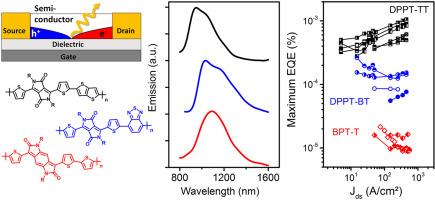Photo- and electroluminescence of ambipolar,high-mobility,donor-acceptor polymers |
| |
| Affiliation: | 1. Universität Heidelberg, Institute for Physical Chemistry, 69120 Heidelberg, Germany;2. Friedrich-Alexander-Universität Erlangen-Nürnberg, Department of Materials Science and Engineering, 91058 Erlangen, Germany;3. Imperial College London, Department of Chemistry and Centre for Plastic Electronics, London SW7 2AZ, UK |
| |
| Abstract: | 
Donor-acceptor polymers with narrow bandgaps are promising materials for bulk heterojunction solar cells and high-mobility field-effect transistors. They also emit light in the near-infrared. Here we investigate and compare the photoluminescence and electroluminescence properties of different narrow bandgap (<1.5 eV) donor-acceptor polymers with diketopyrrolopyrrole (DPP), isoindigo (IGT) and benzodipyrrolidone (BPT) cores, respectively. All of them show near-infrared photoluminescence quantum yields of 0.03–0.09% that decrease with decreasing bandgap. Bottom-contact/top-gate field-effect transistors show ambipolar charge transport with hole and electron mobilities between 0.02 and 0.7 cm2 V−1 s−1 and near-infrared electroluminescence. Their external quantum efficiencies reach up to 0.001%. The effect of polaron quenching and other reasons for the low electroluminescence efficiency of these high mobility polymers are investigated. |
| |
| Keywords: | Donor-acceptor polymers Ambipolar Field-effect transistors Electroluminescence Photoluminescence Polaron quenching |
| 本文献已被 ScienceDirect 等数据库收录! |
|

